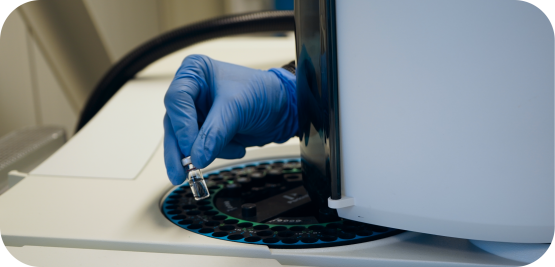(Download: An Overview of BDDE Analysis by GC-MS in PDF by Medistri)
1,4-Butanediol diglycidyl ether (BDDE, CAS No. 2425-79-8) is a chemical compound widely used as a crosslinking agent in the manufacture of hyaluronic acid (HA)-based dermal fillers. Its primary function is to enhance the durability and longevity of these products by binding to HA molecules, increasing their resistance to enzymatic degradation. Given its extensive use in medical and cosmetic applications, ensuring the safety and quality of BDDE-crosslinked products is essential. A key aspect of this assurance lies in the accurate detection and quantification of residual BDDE in HA-based dermal fillers.
Gas chromatography coupled with mass spectrometry (GC-MS) stands out as an ideal analytical technique for this task. GC-MS combines the separation power of gas chromatography with the detection accuracy of mass spectrometry, making it particularly well suited for the identification and quantification of semi-volatile organic compounds such as BDDE.
Principle of GC-MS
During GC-MS analysis, a portion of the sample is introduced into a heated injector, where it is vaporized. The resulting volatile compounds are carried by an inert gas through the chromatographic column, where they are separated based on their volatility and interactions with the stationary phase. As they elute from the column at distinct retention times, the compounds enter the mass spectrometer, where they are ionized—typically via electron impact—and subsequently fragmented. The generated ions are then separated by their mass-to-charge ratio (m/z), producing a unique mass spectrum. Compound identification is performed by comparing the acquired spectra with reference libraries, such as the NIST database.
Application of GC-MS to Residual BDDE Analysis
Detecting residual BDDE in HA-based fillers is critical, as unreacted BDDE may pose health risks. Regulatory agencies, such as the U.S. Food and Drug Administration (FDA), have established safety thresholds for residual BDDE in medical devices, typically recommending levels below 2 ppm (parts per million).
Benefits of Using GC-MS for BDDE Analysis
High Sensitivity and Specificity: GC-MS provides excellent sensitivity, capable of detecting trace levels of BDDE, and allows for specific identification through its mass spectral signature.
Quantitative Accuracy: The technique enables precise quantification, essential for ensuring compliance with safety standards.
Versatility: GC-MS can detect a wide range of compounds, making it suitable for various analytical needs.
Ensuring the safety of HA-based dermal fillers crosslinked with BDDE requires strict monitoring of residual BDDE levels. GC-MS is a reliable and high-performance method, offering the sensitivity and precision necessary for accurate BDDE detection and quantification. By incorporating GC-MS into quality control processes, manufacturers can ensure product safety and meet the expectations of both regulatory bodies and consumers.
Learn more about our Laboratory. To ensure your products meet the highest quality and safety standards, contact our dedicated team at contact@medistri.com.
— The Medistri Team
#Medistri
